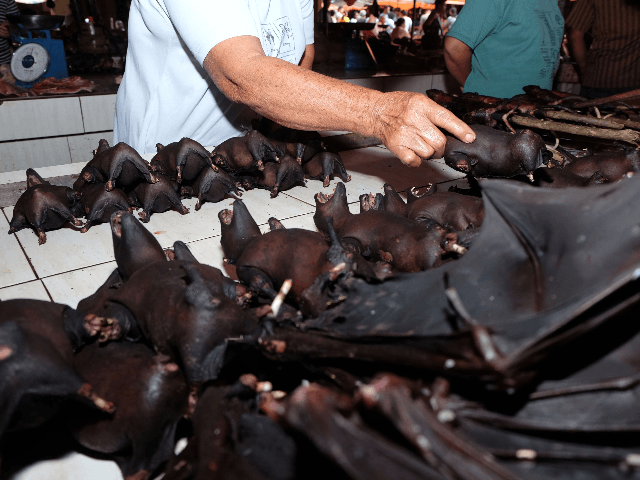The long-awaited World Health Organization (W.H.O.) report on the origins of the Wuhan coronavirus was released on Tuesday, after canceling the release of an interim report in early March.
The final report is lengthy but inconclusive, laying out numerous theories for the origin of the virus but failing to conclusively prove or disprove any of them. Most intriguingly, the authors circle around the shortage of hard evidence for zoonotic transmission – animals to human – even though they insist it is the most likely scenario.
The 120-page report concedes early on that much of the work was done by Chinese Communist Party (CCP) scientists, “gratefully acknowledging” their contributions and noting, without criticism or complaint, that much of the report is based purely on the conclusions of CCP analysts without reference to their source data.
The “joint international team” evaluated four scenarios for the origin of the coronavirus. They concluded the most likely was “introduction through an intermediate host,” which means humans contracted Chinese coronavirus from an animal that contracted it from the source animal in nature. Second most likely was “direct zoonotic spillover,” which means humans caught the disease directly from the animal where it originated.
The CCP’s preferred theory, “introduction through cold/food chain products,” was rated “possible,” while “introduction through a laboratory incident was considered to be an extremely unlikely pathway.”
The report invests a great deal of effort in explaining how it could be possible for the Chinese coronavirus to have originated in another country and spread to the seafood market in Wuhan through shipments of frozen food, but there is scant evidence this actually happened in late 2019, or that the coronavirus broke out anywhere before it appeared in the Wuhan area. The cold-chain hypothesis is based largely on samples of coronavirus coming back to China in more recent times after the Wuhan outbreak spread to cover the entire world.
The report authors said it is possible there was “missed circulation in other countries,” but the “quality of the studies” is limited, and it would appear W.H.O. is largely taking the Communist Party’s word for when the first cases appeared in Wuhan, so it would be difficult to state with confidence that any given foreign infection occurred before anyone in China was infected.
The notable thing about the zoonotic theories is that very little evidence exists that any animals incubated or contracted the coronavirus in nature before the human outbreak began.
“Evidence from surveys and targeted studies so far have shown that the coronaviruses most highly related to SARS-Cov-2 [the Chinese coronavirus] are found in bats and pangolins, suggesting that these mammals may be the reservoir of the virus that causes Covid-19 [Chinese coronavirus disease],” the report stated.
“However, neither of the viruses identified so far from these mammalian species is sufficiently similar to SARS-CoV-2 to serve as its direct progenitor,” the report added, suggesting mink and cats as other species that “may act as a potential reservoir.”
“The presence of SARS-Cov-2 has not been detected through sampling and testing of bats or of wildlife across China … Through extensive testing of animal products in the Huanan market, no evidence of animal infections was found,” the report said, citing studies of over 80,000 animal samples collected from 31 provinces of China.
After reviewing information largely taken on faith from the Chinese government, W.H.O. concluded there could be “unsampled chains of transmission beyond the Hunan market cluster,” the “wet market” the Chinese government originally blamed for launching the coronavirus epidemic. The report added there was “no obvious clustering by the epidemiological parameters of exposure to raw meat or furry animals.” There is, however, some evidence from “molecular sequence data” to believe the outbreak began as early as September 2019.
The authors recommended convening a “global expert group to support future joint traceability research on the origin of epidemics.”
As for the laboratory release hypothesis, certain to be the most controversial section of the report, the W.H.O. investigators stated they “did not consider the hypothesis of deliberate release or deliberate bioengineering of SARS-CoV-2 for release,” claiming the latter has been “ruled out by other scientists following analyses of the genome.”
The only scenario explicitly considered was “accidental infection of staff from laboratory activities involving the relevant viruses,” which would seem to underplay the long-speculated possibility that the laboratory improperly disposed of infected research animals.
The “arguments against” laboratory release assert there is “no record of viruses closely related to SARS-CoV-2 in any laboratory before December 2019, or genomes that in combination could provide a SARS-CoV-2 genome” – which, again, appears to be taking the CCP’s word for it. Likewise, W.H.O. praised the three Chinese laboratories in the Wuhan area for being “well-managed” and reporting no coronavirus-like illnesses among the staff before December.
W.H.O. reported the little-known detail that one of the Wuhan laboratories relocated on December 2, 2019, but “reported no disruptions or incidents caused by the move,” and claimed to have no coronavirus-type viruses in storage.
And that was it for dismissing the laboratory origin theory as “extremely unlikely” Chinese assertions about the safety of the labs and their lack of involvement with coronavirus research. W.H.O.’s recommendation for further study was “regular administrative and internal review of high-level biosafety laboratories worldwide,” not a demand for closer investigation of the Wuhan laboratories or more of the source data China refused to provide.

COMMENTS
Please let us know if you're having issues with commenting.